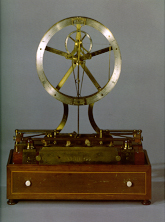
35.8 x 12.6 x 29.3
Brass, iron, wood and ivory
CAT. 1824 : M.III.120
Um pyrometro segundo a ideia de Nollet, feito por Haas.
A pyrometer following Nollet's idea, made by Haas.
This model of pyrometer, according to the Catálogo de Instrumentos de Física prepared by Professor J. H. Figueiredo Freire, was designed by Jean Antoine Nollet.
The apparatus has the peculiarity of having a circular calibrated scale which the pointer moves over, orientated in a vertical plane, leaving visible all the mechanism of cogwheels and shafts. This makes it possible to observe its working during the expansion of the bar heated by four little night lights. It therefore makes a magnificent instrument for instructive purposes.
The dial, 17,7 cm in diameter, is divided into six sectors, each subdivided into 50 equal parts. Apart from this fixed scale, the apparatus has a second circular movable scale. This is divided into fourteen equal parts marked next to the periphery of a cogwheel, 6 cm in diameter, that engages with the teeth on the axle of the main dial. By means of this mechanism, this movable scale turns together with the pointer of the instrument, permitting the number of turns it makes to be counted. For this, a vertical needle placed in front of the movable scale is used as a reference.
This instrument is extraordinarily sensitive. The mechanism of cogwheels, levers and shafts, permits direct observation of the otherwise imperceptible expansions of the bar, via the pointer of the apparatus.
The experimental studies carried out with this type of apparatus did not permit a relationship to be obtained between the expansion of the bars and the temperature. The bars used were all the same length and the experiments tried to compare the expansion of bars of different materials during a determined period of time.
In addition to its use in the experimental study of the linear dilation of bodies, the instrument is also an outstanding example of mechanics.
The example belonging to the Gabinete de Física in Coimbra was constructed by J. B. Haas in Lisbon in 1805.
Nollet, Jean-Antoine, Leçons de Physique Expérimentale, Paris, 1764, Vol. IV, Lec. XIV, p. 18.